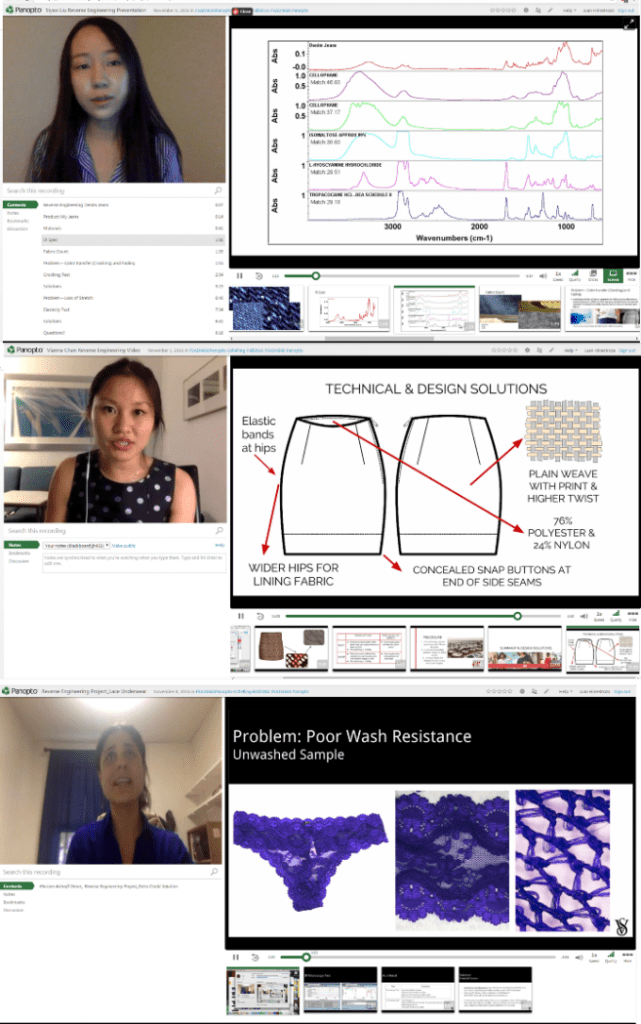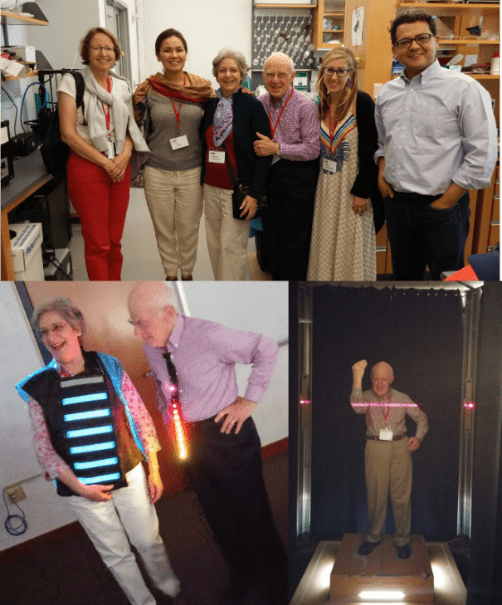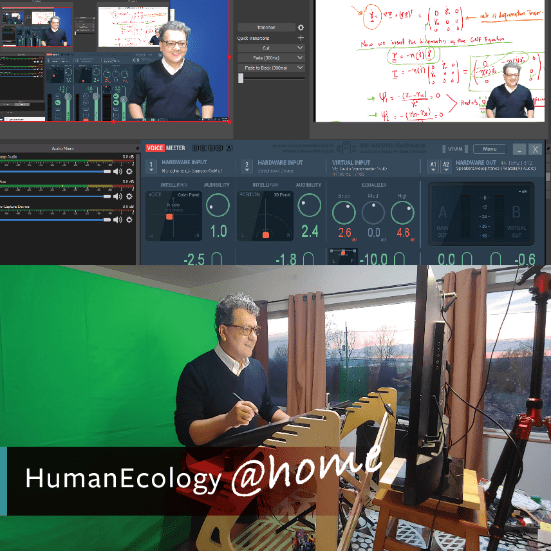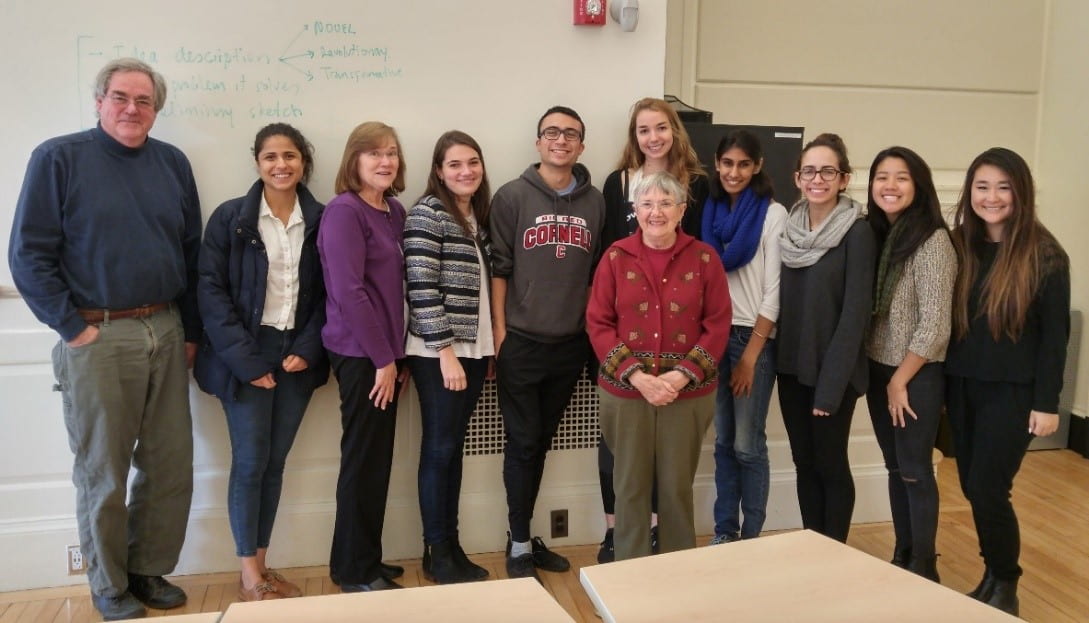Teaching Statement
During my academic career, I have been truly fortunate to teach, to learn about teaching, and to explore new forms of teaching. I have taught undergraduate (FSAD4660), graduate (FSAD6610), and summer extension courses with students ranging in age from 18 to 81 and I have learnt from each of them. I also faced several challenges such as a tumultuous case of multicourse cheating that ended with the expulsion of the student found guilty, and the sudden transition to virtual teaching due to the COVID-19 pandemic. I remain convinced that teaching is not only the best way to master a subject, but it is also a very effective tool to attract talented students to our research group.
Undergraduate Education: Service Learning and Challenging the Limits of Innovation. Since my arrival at Cornell I have been teaching FSAD 4660: Textiles Apparel and Innovation. During my pre-tenure years, I taught it as an intergenerational service-learning course using a grant from the LEAP (Living Environments Aging Partnership) program to bring local senior citizens to the classroom to share some of the challenges they face with aging. FSAD 4660 students designed solutions addressing those challenges and received feedback from the senior citizens. After the funding from LEAP ended in 2010, I decided to expand the focus of the class from aging to the challenges of common diseases. I recruited a new group of community members—senior citizens that suffer from diabetes and arthritis, and a person with Hirschsprung’s disease. The students’ final posters, describing their innovative solutions for alleviating the health conditions of the community members have been outstanding that they are used by the College’s Office of Admissions as a recruiting tool. Three years ago, I flipped this course with mixed results. I asked for help from the Center for Teaching Excellence at Cornell and I attended several workshops on flipping courses. After learning more about the flipping methodology, I decided that it would be a better idea to have a mixed approach: some lectures are flipped while others have remained traditional lectures that include a group activity. This new approach has been successful and students have expressed positive comments as they discover new ways to see textiles and fibers as vehicles for innovation for a myriad of markets and scenarios outside of fashion.
Three years ago, I added a new dimension to the course by incorporating basic electronics and computer programming. This addition was a direct response to an increased interest by FSAD students in wearable electronics. It is always a challenge to teach technical content to a non-technical audience that unfortunately, due to the limitations of the existing curriculum, has no background in computer programming or electronic tinkering. However, using DIY components from Adafruit, I was able to teach fundamental concepts of computer programming and basic electrical circuitry. Some of the projects developed by the 4660 students include shoes with lights activated by a piezo membrane, a hat with an SPF indicator, an umbrella that lights up in the dark, and a tie that activates LEDs in response to surrounding sound.
 I also introduced the use of Panopto to FSAD 4660. Panopto is a video content platform that allows for easy integration of Powerpoint slides with video of the presenter. In one of the major assignments in FSAD4660, called “Reverse Engineering”, students analyze in detail the many reasons why a textile product fails to meet expectations. The failure analysis is performed by considering design and materials perspectives. The students present their analysis to the class and their live presentations are recorded. After the original recording, the students are encouraged to improve their presentation by making their own videos using Panopto. I learned that many students use these videos as evidence of their presentation and analytical skills during job interviews. My goal is to continue adapting FSAD4660 to current trends in innovation and to create a second undergraduate course in which some of these novel ideas can be built and tested. For that reason, I have been in conversations with “REV: Ithaca Startup Works” to explore the potential of these innovative ideas through the REV:Hardware Accelerator Program. My overall objective is to embed into our students’ minds the idea that they can make a better world through fibers and textiles innovation.
I also introduced the use of Panopto to FSAD 4660. Panopto is a video content platform that allows for easy integration of Powerpoint slides with video of the presenter. In one of the major assignments in FSAD4660, called “Reverse Engineering”, students analyze in detail the many reasons why a textile product fails to meet expectations. The failure analysis is performed by considering design and materials perspectives. The students present their analysis to the class and their live presentations are recorded. After the original recording, the students are encouraged to improve their presentation by making their own videos using Panopto. I learned that many students use these videos as evidence of their presentation and analytical skills during job interviews. My goal is to continue adapting FSAD4660 to current trends in innovation and to create a second undergraduate course in which some of these novel ideas can be built and tested. For that reason, I have been in conversations with “REV: Ithaca Startup Works” to explore the potential of these innovative ideas through the REV:Hardware Accelerator Program. My overall objective is to embed into our students’ minds the idea that they can make a better world through fibers and textiles innovation.
Graduate Education: Everything Flows—a foundation in rheology. FSAD 6160 Rheology of Solids is a graduate course that I created upon arrival at Cornell back in 2006. The course is mandatory for graduate students in the field of Fiber Science, and over the years, it has attracted students from Materials Sciences and Engineering (MSE), Chemical Engineering (CHEME), Biomedical Engineering (BME), Mechanical Engineering, and Food Science. FSAD 6160 is now included in the curriculum of MSE and CHEME as it is the only rheology course offered on campus. The course covers fundamental theory of rheological measurements for rotational and capillary rheometers as well as dynamic mechanical analyzers. The course has theoretical and practical components, so every year I select a set of viscoelastic materials that the students use to learn about concepts such as yield stress, normal stress differences, viscoelasticity, and time-dependent deformation responses. I usually ask students to group-teach a special topics lecture at the end of the course. This activity has proved to be quite popular and some of these lectures have been very innovative, including clever demonstrations to explain concepts such as birefringence, constitutive equations, magneto-rheology, as well as flow instabilities.
FSAD 6160 is a course that requires a very strong mathematical background in differential equations and tensorial calculus, which represents a challenge for some students. Because of this, I decided to spend the first two weeks of the course covering some of the basic mathematical concepts in order to allow students to strengthen their mathematical skills. We also migrated from using Excel spreadsheets to using Matlab for mathematical modeling. Since some students are not completely familiar with Matlab, I coordinated with the Computer Science department at Cornell to register FSAD 6160 students in an 8-week introductory Matlab course. This has proved to be a good initiative as students leave FSAD 6160 with strong mathematical and modeling skills that are of great use for their individual research projects.
 Summer Extension Courses: Connecting with alumni and reaching out to non-traditional learners. I have taught a one-week course through the Cornell Summer Adult Education Program. The summer course aims at informing alumni and non-traditional learners about the innovations in fiber and textile sciences. The course is very challenging to teach as the audience is quite diverse and encompasses different professional backgrounds and interests including attorneys, entrepreneurs, politicians, artists, and many others. In one week, I lecture on basic concepts and recent developments in fiber science and conduct an interactive tour of the FSAD research facilities. This course has allowed me to hone my abilities to speak in front of non-technical audiences and has made me a better communicator of science to the public. One of the lectures delivered during the summer course was can be found at https://youtu.be/e3Ti7_x6KRg
Summer Extension Courses: Connecting with alumni and reaching out to non-traditional learners. I have taught a one-week course through the Cornell Summer Adult Education Program. The summer course aims at informing alumni and non-traditional learners about the innovations in fiber and textile sciences. The course is very challenging to teach as the audience is quite diverse and encompasses different professional backgrounds and interests including attorneys, entrepreneurs, politicians, artists, and many others. In one week, I lecture on basic concepts and recent developments in fiber science and conduct an interactive tour of the FSAD research facilities. This course has allowed me to hone my abilities to speak in front of non-technical audiences and has made me a better communicator of science to the public. One of the lectures delivered during the summer course was can be found at https://youtu.be/e3Ti7_x6KRg
Virtual Teaching through a pandemic: 2020 has been a year of incredible challenges to academic  institutions as faculty was forced to change research and teaching methodologies due to COVID-19. Based on feedback from my students, I learned that they preferred interactive teaching and the use of a handwriting blackboard rather than traditional lecturing using PowerPoint Slides. With the help of several YouTube videos, I built a home-based green screen studio using a large piece of green fabric and some light fixtures. The green screen allowed for the projection of a virtual whiteboard using two pieces of open-source software: OBS Studio and Banana Meeter. The whiteboard was achieved using Microsoft OneNote, and a Wacom tablet. OneNote allows for free-form information gathering and multi-user collaboration via handwritten notes, drawings, screen clippings, and video links. As the pandemic of CoVID-19 continues and universities are forced to migrate to hybrid or online instruction modes, this experience has proved to be of tremendous value and I have shared my tools and strategies with several faculty members at Cornell who have interests in virtual interactive teaching experiences.
institutions as faculty was forced to change research and teaching methodologies due to COVID-19. Based on feedback from my students, I learned that they preferred interactive teaching and the use of a handwriting blackboard rather than traditional lecturing using PowerPoint Slides. With the help of several YouTube videos, I built a home-based green screen studio using a large piece of green fabric and some light fixtures. The green screen allowed for the projection of a virtual whiteboard using two pieces of open-source software: OBS Studio and Banana Meeter. The whiteboard was achieved using Microsoft OneNote, and a Wacom tablet. OneNote allows for free-form information gathering and multi-user collaboration via handwritten notes, drawings, screen clippings, and video links. As the pandemic of CoVID-19 continues and universities are forced to migrate to hybrid or online instruction modes, this experience has proved to be of tremendous value and I have shared my tools and strategies with several faculty members at Cornell who have interests in virtual interactive teaching experiences.

